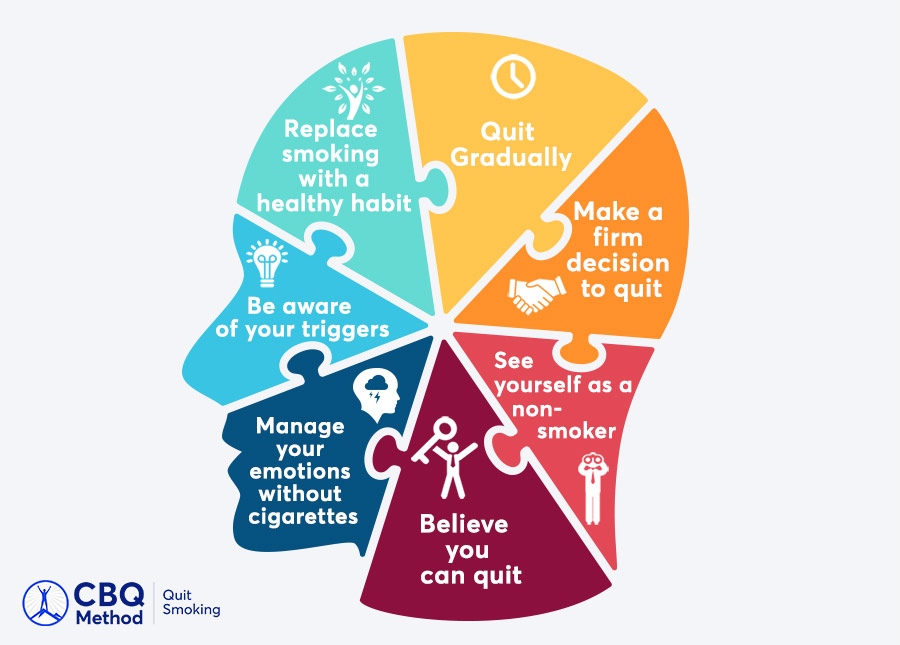Do you want to quit and avoid any future smoking relapse so you can finally break free from this addiction?
Perhaps you’re worried or afraid that your next quit attempt might fail.
Maybe you have failed in the past, and you don’t want this to happen again.
Or maybe you quit before but started smoking again in an unexpected moment of weakness; you had a bit too much to drink, a friend offered you a cigarette, or worse, you got some bad news, and you didn’t know how to cope.
If any of the above has happened to you, then this article is for you.
Because I will show you how to avoid smoking relapse so you can stop smoking for good.
No matter what happens in your life.
See, I also failed to quit many times.
And it was only after creating the CBQ method, that I was able to quit smoking successfully and understand why we relapse, and how to prevent that.
The reason we relapse is this: we don’t prepare adequately for our attempt.
And because of that, we don’t know how to protect ourselves in vulnerable moments.
Now I am not saying there won’t be vulnerable moments after you quit. Life gets hard for all of us, and we can’t avoid that.
But what we can avoid is to start smoking again.
And there are 7 ways to do that.
7 ways you can prepare for your next attempt so you can quit and dodge a quit smoking relapse.
Some of these ways are exercises and techniques while others are different ways to think about smoking.
But all of these practices come from the CBQ method; the quit smoking method that has 94% success rate.
So I know that if you apply all seven, you will stop smoking naturally and never feel tempted to smoke another cigarette in your life.
How to Avoid Smoking Relapse
1. Don’t Quit for the Rest of Your Life
Wait. Isn’t that the point?
Well, yes.
The point is to quit for the rest of your life. And to never miss cigarettes again.
But.
If you say to yourself “I am quitting smoking forever; for the rest of my life,” chances are that you will feel overwhelmed.
Thinking “I will never smoke again” probably makes you feel deprived.
I mean, “forever” or “never” are big words that make your goal to stop smoking seem unattainable.
And nobody needs this extra stress when quitting. Right?
But what if you broke down your goal to stop smoking to more approachable steps?
Wouldn’t this make quitting seem easier, more achievable and permanent?
It would!
How to Quit Without Feeling Overwhelmed
You need to take it one day at a time.
Here’s what I mean: If you set your intention to stay smoke-free one day at a time… then quitting smoking becomes much easier and a quit smoking relapse becomes much harder.
You get to celebrate every day you are smoke-free.
And you go to bed at night feeling proud of yourself.
Now if you think you’re going to crack without smoking during the day, tell yourself “I can have a smoke in an hour or so if I really want one.”
By that time, you’d probably have forgotten about it.
Something else you can do is to calculate the money saved each day you don’t smoke. Click here to calculate how much money you will save by quitting smoking.
2. Make a Real Decision to Quit
If you don’t really decide to stop smoking, then it is very likely to encounter a relapse.
Here’s what I mean.
Saying: “I should stop smoking” or “I will try and see how it goes,” is not making a firm decision to quit.
Really now, how many shoulds do you say every day?
“I should eat healthier.”
“I should exercise more.”
“I should call that person.”
But how many of these shoulds do you actually do?
Probably none.
The same applies to quitting smoking.
Knowing or saying that you should quit is not enough to make you take action.
Your logic just can’t overpower the emotional connection you have with your habit.
You know you want to quit – but there is still something tempting you to smoke.
What’s tempting you is that you haven’t REALLY decided to quit.
Making a firm decision overcome this addiction is the first quit smoking stage of the CBQ method, called “Choose to Quit.”
If you smoke your last cigarette before completing this first stage, you will relapse the moment you feel tempted.
But if you follow this stage and decide to stop smoking the right way, then nothing will stop you from succeeding.
3. See Yourself as A Non-Smoker
Being able to visualize your smoke-free self will motivate you to kick this habit permanently.
But at the moment, being a non-smoker, it is out of your perception.
Or even worse, it is a painful image!
And why on earth would you want to go through a painful process to achieve a painful result?
You wouldn’t.
If you have no empowering and compelling way of seeing yourself as a non-smoker…
And if you can’t imagine how good it feels to be a nicotine-free…
How can you actually quit?
It’s hard.
How to Visualize Yourself as A Non-Smoker Even If You’ve Recently Started Smoking Again
You will stop smoking and avoid any potential smoking relapse if you create a compelling yet realistic image of yourself as a happy non-smoker.
You have to like the idea of being healthy more than the idea of having a smoke with your coffee.
Really.
You must be able to feel all the benefits you will gain by stopping smoking:
•be healthy once again
•get your peace of mind back
•breathe better
•have more energy
•stop worrying about how smoking might be harming your health
•get rid of the cigarette smell
•stop wasting a fortune on cigarettes
•reclaim the lost youth from your appearance
•and live a long life with your loved ones.
•Or maybe just you are sick of being controlled by a nicotine stick.
Just imagine all the benefits of quitting smoking.
Imagine yourself being free.
And keep this image in your mind every time you feel like starting smoking again.
4. Believe Quitting is Possible for You
I’ve seen confident and persistent people believing they can do anything… except quitting smoking.
Or even worse, they try to quit without having a deep empowering and encouraging belief that they will be successful.
The problem?
If deep inside you believe that you are going to smoke again, then that’s exactly what’s going to happen.
Believing that you can’t quit smoking for good, is a limiting belief.
Limiting beliefs are all the things we think we can’t do.
Sometimes we believe we’re not good enough or strong enough to achieve our goals.
Other times we believe other people who tell us we can’t do certain things.
Has anyone ever told you that you couldn’t achieve a goal you set?
How did that affect your psychology and your belief in yourself?
If you believe you can’t quit smoking, then you will always feel that something is making you go back to smoking- and that’s your own beliefs.
Nothing more.
But if you have faith in yourself, then it will be easy to remove all the fears and obstacles that prevent you from becoming a happy non-smoker.
That’s why the second quit smoking stage, “Change Your Mindset,” is all about strengthening your belief that:
- That it is possible to quit.
- AND that you can do it.
5. Learn How to Manage Your Emotions Without Cigarettes
There is no doubt that smoking helps you cope when you’re feeling stressed or down.
Every time you light up a cigarette you do it either to boost a good emotional state or escape from a bad one.
Think about it.
When you are stressed, you will probably light up a cigarette or two to relax.- escape
When you are happy, you will smoke to complete that fulfilling moment- boost
When you are depressed you will smoke to feel better- escape
Cigarettes have become your comfort and your friend because they are always available to you when you need them.
That’s why it might be hard to avert a relapse after quitting smoking.
The only way to stop smoking permanently without feeling anxious and deprived is to go through the 3rd quit smoking stage.
During the third stage of the CBQ method, which is “Change your Smoking Pattern,” you learn how to relax, cope with boredom, socialize, concentrate and enjoy life better without cigarettes.
Just imagine how it would be like if you didn’t need your smokes to go through your day.
Learn how to apply the 3rd quit smoking stage. Just enter your name and email address so that I can send you the link to the video of the 4 quit smoking stages of the CBQ method.
Moving on…
6. Think Before Lighting Up
Behind every cigarette you smoke, there is a smoking trigger.
Smoking triggers are all the emotions, states, and situations that make you light up- instantly.
Most triggers are common to all smokers, but you also have your own smoking triggers that come from your lifestyle.
For example, drinking coffee, finishing your meal or feeling stressed… will probably trigger a cigarette craving.
Or if you habitually smoke in your living room, then after a while just being in your living room will be enough to increase your craving for a cigarette.
The problem is that when you encounter any smoking trigger, you light up without second-guessing it.
This automatic response is what makes your habit strong. That’s how you relapse.
And since there will always be a smoking trigger to remind you of your habit, the only solution is for you to take control over your triggers – instead of them controlling you.
That’s why one of the crucial steps in avoiding quitting smoking relapse, is being aware of your triggers.
And when you want to smoke, take a moment before you light up.
At first, wait for 10 seconds.
After a while, start waiting for 15 seconds, then 20 seconds and so on.
Extend the waiting period for as long as you can.
7. Have an Alternative
What smokers usually do is they try to resist smoking with willpower hoping that the desire to smoke will eventually fade away.
And it doesn’t.
On the contrary, the more you resist smoking, the more you intensify your urge to smoke.
Because you think about it more!
The reason this happens is simple: You can’t just suppress or forget something you’ve been doing at least 20 times per day for decades.
It’s impossible.
The only permanent way to break free and be safe from any future smoking relapse is to find healthy habits to replace smoking.
The 4th and last quit smoking stage of the CBQ method, “Condition Your Smoke-Free Life,” shows you how to remain a non-smoker by replacing smoking with another healthy habit.
Not another crutch or addiction. But with a beneficial, healthy habit.
But be careful. This new habit has to:
1. Satisfy the same emotional needs that you currently fulfill with smoking.
It has to fight boredom, stress and offer you relaxation and pleasure.
2. Occupy your mind and hands at the same time.
As long as your new habit follows the above parameters, it will help you find satisfaction and connection in other things instead of smoking.
Conclusion
The easiest and safest way to avoid quit smoking relapse is to quit while applying these 7 principles:
And if you have recently started smoking again, then try to quit again using these 7 ways.
But do it now that you still have momentum.
Each of these 7 practices to fend off smoking relapse comes from a quit smoking stage of the CBQ method.
To access the exclusive video of the 4 quit smoking stages, click here.
Just enter your name and email address so I can send you your video.
These 4 stages are the complete process that takes you from a smoker who enjoys cigarette to a non-smoker who doesn’t need them.






